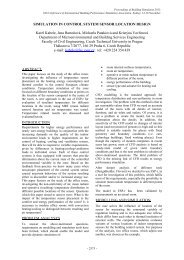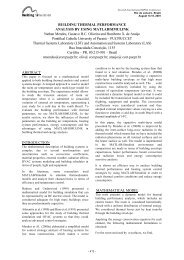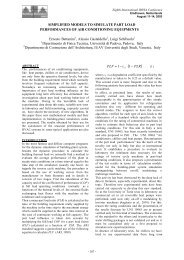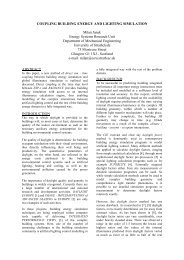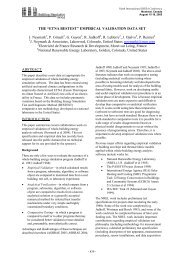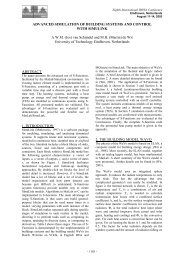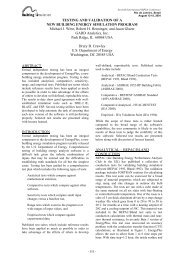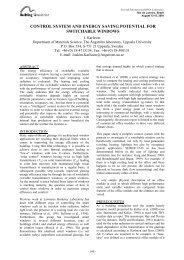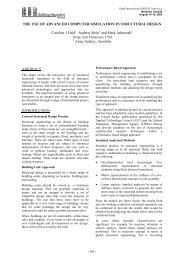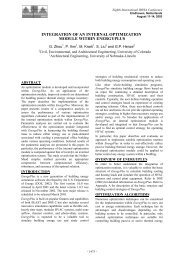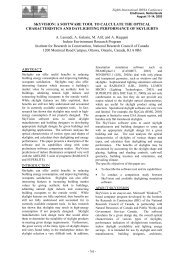WEB-ENABLED AUGMENTED REALITY FOR A DOUBLE ... - ibpsa
WEB-ENABLED AUGMENTED REALITY FOR A DOUBLE ... - ibpsa
WEB-ENABLED AUGMENTED REALITY FOR A DOUBLE ... - ibpsa
Create successful ePaper yourself
Turn your PDF publications into a flip-book with our unique Google optimized e-Paper software.
<strong>WEB</strong>-<strong>ENABLED</strong> <strong>AUGMENTED</strong> <strong>REALITY</strong> <strong>FOR</strong> A <strong>DOUBLE</strong>-SKIN SYSTEM<br />
Young-Jin Kim 1 , Cheol-Soo Park 1<br />
1 Department of Architectural Engineering, SungKyunKwan University, South Korea<br />
E-mail: cheolspark@skku.ac.kr<br />
ABSTRACT<br />
This study is aimed to implement Augmented Reality<br />
(AR) and web-enabled control for a double-skin<br />
system. The AR was realized using a marker, a<br />
webcam, LabVIEW VIs and a simulation model in<br />
MATLAB. AR synchronizes a physical real-world<br />
with a virtually computer-generated image.<br />
Occupants are capable of selecting control modes<br />
(autonomous, energy, thermal comfort, nighttime) or<br />
monitoring relevant information (temperatures,<br />
energy flow through the façade, PMV) by gesture<br />
pattern. The implementation of this AR to any<br />
building system will allow occupants/operators to<br />
easily assess the performance of systems/buildings of<br />
their interest and intelligently control their buildings<br />
in real-time. This feature will contribute to enhancing<br />
an occupant’s comfort and productivity, as well as<br />
building energy reduction and control.<br />
INTRODUCTION<br />
Proceedings of Building Simulation 2011:<br />
12th Conference of International Building Performance Simulation Association, Sydney, 14-16 November.<br />
The benefits of advanced building simulation tools,<br />
computing power, numerical methods as well as the<br />
qualitative and quantitative growth of simulation<br />
experience and knowledge have made possible<br />
extensive use of building simulation for green<br />
building design, performance assessment and control.<br />
Recently, significant progress of Augmented Reality<br />
(AR) has been made due to the rapid development of<br />
ubiquitous computing devices, sensors and the<br />
emerging building simulation tools (Malkawi and<br />
Augenbroe, 2004; Malkawi and Srinivasan, 2005).<br />
AR is a term for a live direct or an indirect view of a<br />
physical, real-world environment whose elements are<br />
augmented by computer-generated sensory input<br />
such as sound, video, graphics or GPS data. This<br />
technology functions by enhancing one’s current<br />
perception of reality (Wikipedia, 2011a). AR will be<br />
very promising when integrated with building<br />
simulation since it is able to show the physical real<br />
world enhanced with computer-generated digital<br />
images out of simulation runs (Milgrram & Kishino,<br />
1994; Milgram et al, 1994; Azuma, 1997; Azuma et<br />
al, 2001).<br />
The control of building systems using ubiquitous<br />
technology (e.g., WI-FI) and building performance<br />
simulation tools involves interplay among devices<br />
and building environment (Poslad, 2009). The<br />
- 855 -<br />
current problem with this interaction is that it<br />
involves a one-directional flow of information from a<br />
device to a user. In this study, the authors aim to<br />
realize a bidirectional flow of information and<br />
control signal using a gesture pattern technique and<br />
AR. The gesture pattern technique is one of ways to<br />
achieve context-awareness (explained later) AR.<br />
To demonstrate such AR, a double-skin system is<br />
selected for this study since it has a significant effect<br />
on the productivity and comfort of occupants. The<br />
double-skin system can control the penetration of<br />
solar radiation and daylight by adjusting the blind<br />
slat angle and induce outdoor air through ventilation<br />
dampers (Stein et al, 2006). The dynamic<br />
characteristics of typical double-skin systems are<br />
strongly nonlinear. The authors published several<br />
work on double skin systems including (1) a lumped<br />
simulation model, (2) on-line parameter estimation,<br />
(3) optimal control, and (4) control modes<br />
(autonomous mode, energy saving mode, thermal<br />
comfort mode, and nighttime mode) (Park et al,<br />
2004; Yoon et al, 2009). Based on the previous<br />
achievements, the authors aim to implement AR for a<br />
double-skin system in this study. With this AR, users<br />
are able to obtain physical information (e.g.,<br />
indoor/outdoor temperature, wind speed, and wind<br />
direction, etc.) and performance information (energy<br />
flow and PMV, etc.) in live real-time. Users can<br />
select preferred control modes via a gesture pattern.<br />
UBIQUITOUS CONTROL<br />
Augenbroe (2002) mentioned that one of the future<br />
trends in building simulation would be web-enabled<br />
or pervasive/invisible environments (Figure 1).<br />
Figure 1 Trends in technical building performance<br />
simulation tools (Augenbroe, 2002)
Proceedings of Building Simulation 2011:<br />
12th Conference of International Building Performance Simulation Association, Sydney, 14-16 November.<br />
In future, use of building simulation in WWW<br />
environment, smart phone, iPad and wall-pad will be<br />
very popular for ubiquitous control and monitoring of<br />
building performance.<br />
Virtual Reality (VR) involves a change in digital<br />
images only. However, AR is more ideal than VR<br />
since it involves the synchronized images between a<br />
simulation results and a physical real world (Lee et al,<br />
2008; Poslad, 2009). Malkawi and Srinivasan (2005)<br />
reported implementation of AR using a<br />
Computational Fluid Dynamics (CFD) program, and<br />
voice and gesture recognition. Through a Head<br />
Mounted Display (HMD), users can see the indoor<br />
airflow pattern out of ‘pre’ stored CFD simulation<br />
results since CFD requires signifcant computation<br />
time.<br />
The information and control signal flow of AR in this<br />
study are shown in Figure 2. The server computer<br />
first collects data through data logging devices<br />
including solar radiation (direct, diffuse), wind<br />
direction, wind speed, temperatures (outdoor, indoor,<br />
glazing, cavity air), and cavity air velocity, etc. The<br />
relevant data are used as simulation inputs for the<br />
lumped simulation model. In particular, unknown<br />
parameters in the simulation model (convective heat<br />
transfer coefficients, flow coefficient, flow exponent<br />
and form loss factor) are identified and the model is<br />
so called self-calibrating. The details are reported in<br />
(Yoon et al, 2009). By the use of the calibrated<br />
simulation model, detailed performance information<br />
(e.g., heat gain/loss in the room space by convection<br />
and radiation on the interior glazing, and penetration<br />
of direct and diffuse solar radiation) can be<br />
calculated (Yoon et al, 2009). The measured physical<br />
data (e.g., outdoor/indoor temperature, wind speed,<br />
and wind direction) and calculated information (e.g.,<br />
energy flow and PMV) are posted to the user’s<br />
computer (smartphone and PDA) in real-time (more<br />
details: Park 2004; Yoon et al 2009). The LabVIEW<br />
optimization routine installed in the local server finds<br />
optimal control variables (blind slat angle, opening<br />
ratio of ventilation dampers). The optimal controller<br />
then actuates motors to change the blind slat angle<br />
and ventilation dampers.<br />
<strong>WEB</strong>-BASED OPTIMAL CONTROL OF<br />
THE <strong>DOUBLE</strong>-SKIN SYSTEM<br />
A test unit was constructed for this study (Figure 3).<br />
The test unit has a full scale double skin system<br />
(exterior double glazing: 6 mm clear + 12 mm air<br />
space + 6 mm low-e; interior double glazing: 6 mm<br />
clear + 6 mm air space + 6 mm clear), an automatic<br />
rotating blind, and inlet/outlet ventilation dampers.<br />
Installed sensors include a weather station<br />
(Windsonic, Gill), solar direct/diffuse radiation<br />
sensor (LI-200SA), cavity air velocity sensor (T-<br />
06995100, Testo), outdoor/indoor pressure<br />
differential sensor (T-6343, Testo), hygrometers<br />
(HTX62C Series, DOTECH), T-type thermocouples.<br />
(a) Exterior (b) Interior<br />
Figure 3 The test unit of the double-skin system<br />
In this study, the authors used the mathematical<br />
model that was published in (Yoon et al, 2009)<br />
without any modification. The state variables (x1-x8)<br />
and unknown convective heat transfer coefficients<br />
(h) are shown in Figure 4. In most simulation runs, a<br />
gap exist between calculated and measured state<br />
variables values due to (1) assumptions<br />
simplifications in the modeling process, (2)<br />
unmodeled dynamics, and (3) unknown parameters.<br />
In this study, the mathematical model was calibrated<br />
and using the on-line calibration technique (Yoon et<br />
al, 2009). The on-line calibration process involves<br />
Figure 2 The information and control signal flow of AR for a double-skin system<br />
- 856 -
Proceedings of Building Simulation 2011:<br />
12th Conference of International Building Performance Simulation Association, Sydney, 14-16 November.<br />
the estimation of unknown parameters by minimizing<br />
the difference between predicted and measured<br />
values.<br />
h out<br />
h ca1<br />
x7<br />
x<br />
x<br />
x1 x2 3<br />
x<br />
6<br />
h ca2<br />
h ca3<br />
5<br />
h ca4<br />
h ca5<br />
Figure 4 The state variables and convective heat<br />
x<br />
x<br />
transfer coefficients (simplified system in 2D)<br />
The performance of the double-skin system can be<br />
assessed based on energy, visual comfort, thermal<br />
comfort, ventilation, sound, maintenance, etc. In this<br />
study, a cost function (J) includes energy and thermal<br />
comfort terms only for sake of simplicity. This cost<br />
functions are shown in Equations (1) and (2). The<br />
optimal control calculates control variables which<br />
minimize the cost function during the given time<br />
horizon, as shown in Equation (3) (Park et al 2004).<br />
t 2æ - r1 ( Qcv, rd + Qsol, trans + Qair + QDA)<br />
ö<br />
J heat = ò<br />
dt<br />
t1<br />
ç ÷<br />
2<br />
+ r2 ( PMV )<br />
÷<br />
è ø<br />
t 2æ r1 ( Qcv, rd + Qsol, trans + Qair - QDA)<br />
ö<br />
Jcool = ò ç dt<br />
t1<br />
ç ÷<br />
2<br />
+ r2 ( PMV )<br />
÷<br />
è ø<br />
min J ( f,<br />
AFR, OR)<br />
s. t.<br />
- 90 £ f £ 90<br />
o o<br />
AFR = 1,2,3,4,5,6,7,8,9,10,<br />
0 £ OR £ 100(%)<br />
Where,<br />
r i : relative weighting factor (dimensionless)<br />
Q cv, rd<br />
: heat gain in the room space by convection<br />
and radiation on the interior glazing (W)<br />
Qsol,<br />
trans<br />
: sum of transmitted direct and diffuse solar<br />
radiation (W)<br />
: heat gain in the room space due to a<br />
Q air beneficial airflow regime from the cavity to<br />
the room space or outside (W)<br />
Q DA<br />
: energy savings<br />
autonomy (W)<br />
due to daylighting<br />
4<br />
8<br />
(3)<br />
PMV : Predicted Mean Vote (dimensionless)<br />
(1)<br />
(2)<br />
f<br />
- 857 -<br />
AFR<br />
: blind slat angle (0°: horizontal, 0°~90°:<br />
towards the sky, -80°~0°: towards the<br />
ground)<br />
: Air Flow Regime (Yoon et al, 2009;<br />
dimensionless)<br />
OR : opening ratio of the ventilation damper(%)<br />
The user interface for WWW control was developed<br />
using Web Publishing Tool in LabVIEW 2009 TM<br />
(Figure 5). The local server logs data with a sampling<br />
time of 1 minute (eight state variables, ambient<br />
weather information) from the test unit and the<br />
weather station. Users can monitor the data in any<br />
standard web browser (Figure 5(a)). Users can<br />
choose preferred control modes (energy mode,<br />
thermal comfort mode, automatic mode, night<br />
ventilation mode, and user’s preferred mode) in the<br />
web browser (Figure 5(b)). Once the mode is chosen,<br />
relative weighting factors in Equation (1) are<br />
adjusted. Through the gesture pattern technique that<br />
will be explained later, users can also choose<br />
preferred information.<br />
(a) Input variables in the web browser<br />
(b) Control results in the web browser<br />
Figure 5 Web-based monitoring and control
<strong>AUGMENTED</strong> <strong>REALITY</strong><br />
Context-awareness AR<br />
In this study, the authors used ARTag for<br />
implementing AR. ARTag is developed by Mark<br />
Fiala, a researcher at the National Research Council<br />
of Canada (Cawood and Fiala, 2007). ARTag is an<br />
"Augmented Reality" system where virtual objects,<br />
games, and animations appear to enter the real world.<br />
ARTag use arrays of the square ARTag markers<br />
added to objects or the environment allowing a<br />
computer vision algorithm to calculate the camera<br />
"pose" in real time, allowing the CG (Computer<br />
Graphics) virtual camera to be aligned (ARTag,<br />
2009). The markers play a role as a medium in<br />
connecting the virtual environment and the<br />
computer-generated digital image. General maker<br />
patterns in ARTag are shown in Figure 6. For this<br />
study, ARTag is selected since it can be easily<br />
applied to our system without costing significant<br />
labor, time, and cost.<br />
Figure 6 Maker patterns in ARTag<br />
ARTag usually shows not dynamic but static<br />
information. In this study, the authors used a<br />
MATLAB (ver. 2008b) program<br />
(‘3d_augmentations_usb.exe’,) that can update<br />
information of the markers. By capturing the<br />
information of the marker gathered from the webcam,<br />
the server computer shows in real-time dynamic<br />
information (temperature, energy flow, and PMV).<br />
Consequently, users receive dynamic physical and<br />
performance information of the double-skin system<br />
at a sampling interval of 1 minute (Figure 7).<br />
Client<br />
AR<br />
Proceedings of Building Simulation 2011:<br />
12th Conference of International Building Performance Simulation Association, Sydney, 14-16 November.<br />
Actuator<br />
Computer-generated imagery<br />
(WWW)<br />
Webcam image<br />
Lab<br />
VIEW<br />
Server<br />
HMD & Marker<br />
Figure 7 The presence of dynamic information using<br />
the context-awareness AR<br />
- 858 -<br />
Context awareness originated as a term from<br />
ubiquitous computing or as so-called pervasive<br />
computing which sought to deal with linking changes<br />
in the environment with computer systems, which are<br />
otherwise static. Context awareness refers to the idea<br />
that computers can both sense, and react based on<br />
their environment. Devices may have information<br />
about the circumstances under which they are able to<br />
operate and based on rules, or an intelligent stimulus,<br />
react accordingly. The term context-awareness in<br />
ubiquitous computing was introduced by Schilit<br />
(1994). Context aware devices may also try to make<br />
assumptions about the user's current situation. Dey<br />
(2001) define context as "any information that can be<br />
used to characterize the situation of an entity."<br />
(Wikipedia, 2011b)<br />
In this study, context awareness was realized via the<br />
gesture pattern technique. In other words, users can<br />
transmit their interesting information or content using<br />
the gesture. For the realization of context-awareness<br />
AR, the following three steps were employed.<br />
Ÿ Step 1 (Markers to 3D images): First, markers<br />
are linked to pre-defined 3D images (Table 1).<br />
To make 3D images, *obj (3D image) and *mtl<br />
(color information) files were made using 3D<br />
Max.<br />
Table 1<br />
Information of the corresponding markers<br />
Markers<br />
3D<br />
Images<br />
Descriptions<br />
ET Exterior Temperature<br />
IT Interior Temperature<br />
EF Energy Flow<br />
TC Thermal Comfort (PMV)<br />
0-9 Numbers<br />
- Negative number<br />
. Sign of decimal<br />
℃<br />
W<br />
On/Off<br />
Unit<br />
Sign(physical/performance<br />
information)<br />
Ÿ Step 2 (Context-awareness): Users can select<br />
physical and performance information using the
Proceedings of Building Simulation 2011:<br />
12th Conference of International Building Performance Simulation Association, Sydney, 14-16 November.<br />
(a) Autonomous (b) Energy saving<br />
(c) Thermal comfort (d) Nighttime<br />
Figure 12 Experimental results of the gesture<br />
patterns for control mode (webcam display)<br />
(a)Physical Information (b)Performance Information<br />
Figure 13 Selction of imformation modes using AR<br />
(webcam display)<br />
The real application of the context awareness AR is<br />
illustrated in Figure 14. With use of a very simple<br />
device (webcam), the context awareness AR became<br />
a reality in this study. Obviously, this AR technology,<br />
Figure 11 HCI module using context-awareness AR<br />
- 860 -<br />
when combined with building siumlation, can<br />
provide challenging opprotunities for users and<br />
building operators for energy savings, learning their<br />
buildings, better interaction between users and<br />
systems.<br />
CONCLUSION<br />
In this study, the context awareness AR of the<br />
double-skin system was realized. Sensors and<br />
measuring devices were used and the lumped<br />
simulation model, self-calibration, and optimal<br />
control were also applied. The context awareness AR<br />
was successfully implemented with the use of very<br />
simple device (webcam) and programs that are<br />
already available in LabVIEW and MATLAB<br />
toolboxes.<br />
The paper demonstrates that users can access<br />
physical and performance information of the doubleskin<br />
system in real-time and select their choice using<br />
the gesture pattern technique. By combining virtual<br />
computer-generated image and real world image,<br />
there can be additional opportunities. It allows users<br />
to learn about the performance of their<br />
systems/buildings and intelligently control their<br />
building environment with augmented images in realtime.<br />
Ultimately, users can monitor control variables<br />
(blind slat angle, and ventilation damper) and decide<br />
on their own optimal control variables.<br />
The results obtained for the context-awareness AR<br />
may be applied to many other building systems (e.g.,<br />
HVAC, ventilation, and lighting or a whole building).
Following the successful application of the contextawareness<br />
AR, future work may include:<br />
Ÿ Augmented reality using portable computers:<br />
The realization of augmented reality using<br />
various portable computing devices (smart<br />
phone, iPad, Tablet PC).<br />
Ÿ Visualization of more various physical and<br />
performance information (e.g., indoor airflow,<br />
IAQ, illuminance, luminance, energy use, CO2<br />
emission, maintenance cost, etc.).<br />
REFERENCES<br />
Proceedings of Building Simulation 2011:<br />
12th Conference of International Building Performance Simulation Association, Sydney, 14-16 November.<br />
(a) Monitor of client PC, (b) Physical information (ET: Exterior Temperature, IT: Indoor Temperature),<br />
(c) Performance information (EF: Energy Flow, TC: Thermal Comfort)<br />
Figure 14 Context-awareness AR (client computer)<br />
ARTag. 2009. http://www.artag.net/<br />
Augenbroe, G. 2002. Trends in building simulation,<br />
Building and Environment, Vol.35, pp.891-902.<br />
Azuma, T.R. 1997. A survey of augmented reality,<br />
Presence: Teleoperators and Virtual<br />
Environments, Vol.6, No.4, pp.355-385.<br />
Azuma, T.R., Baillot, Y., Behringer, R., Feiner, S.,<br />
Julier, S. and MacIntyre, B. 2001. Recent<br />
advances in augmented reality, IEEE Computer<br />
Graphics and Applications, Vol.21, No.6, pp.34-<br />
47.<br />
Cawood, S. and Fiala, M. 2007. Augmented Reality:<br />
A Practical Guide, Pragmatic Bookshelf.<br />
Dey, A.K. 2001. Understanding and Using Context,<br />
Personal Ubiquitous Computing Vol.5, No.1, pp.<br />
4–7.<br />
- 861 -<br />
Lee, J.Y., Seo, D.W. and Rhee, G. 2008.<br />
Visualization and interaction of pervasive<br />
services using context-aware augmented reality,<br />
Expert Systems with Applications, Vol.35,<br />
pp.1873-1882.<br />
Malkawi, A. and Augenbroe, G. 2004. Advanced<br />
Building Simulation, Spon Press.<br />
Malkawi, A.M. and Srinivasan, R.S. 2005. A new<br />
paradigm for Human-Building Interaction: the<br />
use of CFD and Augmented Reality, Automation<br />
in Construction Vol.14, pp.71-84.<br />
Milgram, P. and Kishino, P. 1994. A taxonomy of<br />
mixed reality visual displays, IEICE<br />
Transactions on Information Systems, Vol.E77-<br />
D(12), pp.1321-1329.<br />
Milgram, P., Takemura, H., Utsumi, A. and Kishino,<br />
F. 1994. Augmented reality: a class of displays<br />
on the reality-virtuality continuum, SPIE Proc.:<br />
Telemanipulator and Telepresence Technologies,<br />
2351m, pp.282-292.<br />
Park, C.S., Augenbroe, G., Sadegh, N., Thitisawat, M.<br />
and Messadi, T. 2004. Real Time Optimization<br />
of a Double-skin Facade based on Lumped<br />
Modeling and Occupant Preference, Building<br />
and Environment, Vol.39, No.8, pp.939-948.<br />
Poslad, S. 2009. Ubiquitous Computing Smart<br />
Devices, Environments and Interactions, John<br />
Wiley & Sons Ltd.
Proceedings of Building Simulation 2011:<br />
12th Conference of International Building Performance Simulation Association, Sydney, 14-16 November.<br />
Schilit, B.N. and Theimer, M.M. 1994.<br />
Disseminating Active Map Information to<br />
Mobile Hosts. IEEE Network Vol.8, No. 5, pp.<br />
22–32.<br />
Stein, B., Reynolds, J.S., Grondzik, W.T. and Kwok,<br />
A.G. 2006. Mechanical and Electrical<br />
Equipment for Buildings, John Wiley & Sons<br />
Ltd.<br />
Wikipedia. 2011a. http://en.wikipedia.org/wiki/Augmented_reality<br />
Wikipedia. 2011b. http://en.wikipedia.org/wiki/Context-awareness<br />
Yoon, S.H., Park, C.S., Augenbroe, G. and Kim,<br />
D.W. 2009. Self-calibration and Optimal Control<br />
of a Double-skin System, Proceedings of the<br />
11th IBPSA Conference (International Building<br />
Performance Simulation Association), July 27-<br />
30, Glasgow, Scotland, pp.80-87.<br />
- 862 -



